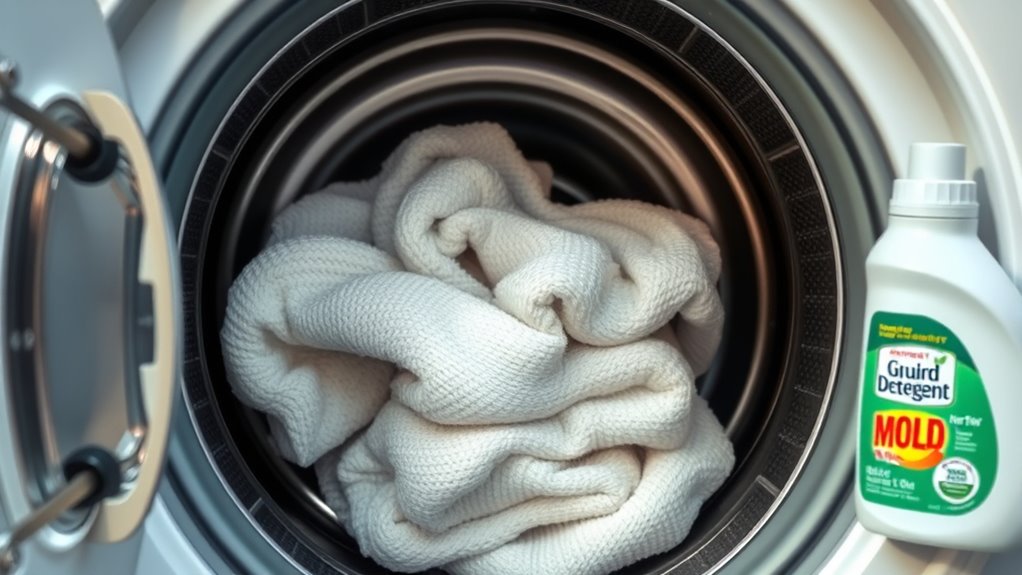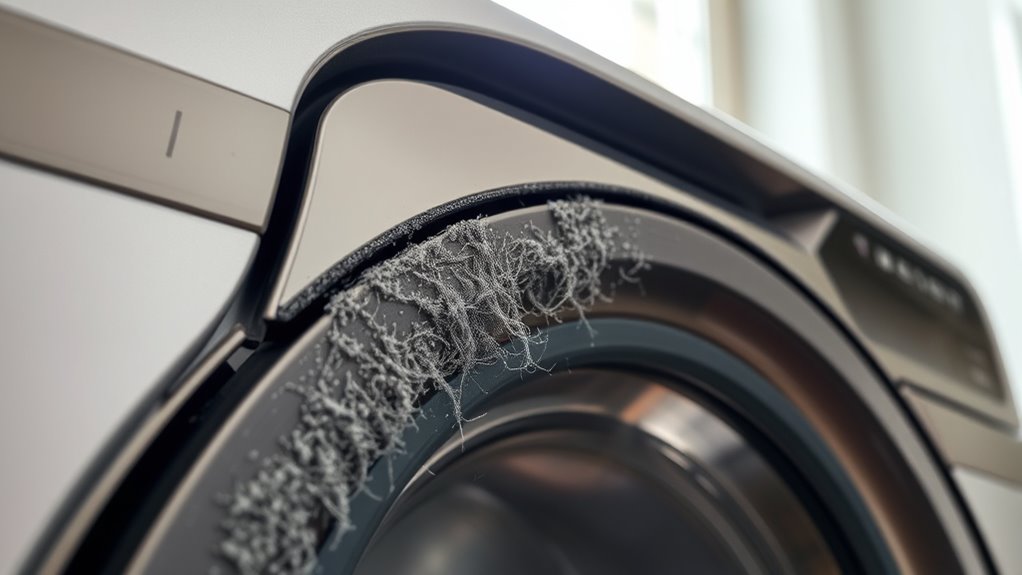To prevent mold in your front-load washer, keep the door and gasket dry after each use, leave the door slightly open to promote airflow, and avoid overloading. Use the right amount of high-efficiency detergent and clean the dispenser regularly. Run maintenance washes with vinegar or washer cleaner weekly and inspect for mold growth, cleaning it promptly. Following these steps helps keep your washer fresh—stick around to discover more tips for a mold-free laundry experience.
Key Takeaways
- Regularly clean the drum, seals, and detergent dispenser to remove residue and prevent mold buildup.
- Leave the washer door slightly open after use to promote air circulation and moisture evaporation.
- Use the correct amount of high-efficiency detergent and avoid overloading to minimize residue and odors.
- Run monthly hot water cycles with vinegar or washer cleaner to disinfect and prevent mold growth.
- Inspect and promptly clean mold-prone areas like door seals and crevices to keep the washer mold-free.
Keep the Door and Gasket Dry After Each Use

After each wash cycle, make sure to wipe the door and gasket dry with a clean cloth. Moisture left behind creates a perfect environment for mold growth. Pay special attention to the rubber gasket, as water often pools in its folds. Use a microfiber cloth or towel to remove any remaining water and prevent dampness from lingering. Keep the door slightly ajar after drying to allow air circulation inside the drum. This helps moisture evaporate and reduces humidity within the washer. Regularly check for any water trapped in crevices or around the gasket. Keeping the door and gasket dry minimizes mold-friendly conditions and promotes a cleaner, fresher washer. Additionally, understanding proper ventilation strategies can help protect your home from potential intrusions while you focus on appliance maintenance. Ensuring good airflow around the appliance can further reduce moisture buildup and mold risk. Incorporating dehumidifiers or fans in laundry areas can also help control ambient humidity levels and prevent mold development.
Use the Right Detergent and Avoid Overloading

Using the right detergent and avoiding overloading your washer are essential steps to prevent mold buildup. Use high-efficiency (HE) detergent in small, recommended amounts—using too much can leave residue that encourages mold growth. Be mindful not to overload the drum; packing it too tightly prevents proper water circulation and rinsing, leading to leftover detergent and moisture that promote mold. Check clothing labels for detergent instructions and stick to them. When washing, opt for the appropriate cycle and temperature to ensure your laundry is cleaned thoroughly and residues are minimized. Regularly using the correct detergent and not overloading helps keep your washer clean and dry, reducing mold-friendly environments inside the drum and seals. Proper appliance maintenance plans can also help detect and prevent issues like mold buildup early on. This simple practice makes a significant difference in maintaining a mold-free front-load washer.
Run Regular Maintenance Washes

Running regular maintenance washes helps remove residue, mold spores, and build-up that can develop over time. These cycles are essential for keeping your washer clean and mold-free. To maximize their effectiveness, consider these steps:
- Use a washing machine cleaner or a cup of white vinegar to break down grime.
- Run the cycle on the hottest setting your manufacturer recommends.
- Leave the door slightly open afterward to allow airflow and drying.
- Incorporate high-temperature cleaning cycles to more effectively eliminate mold spores and bacteria. Proper maintenance can also prevent mold growth from taking hold in hard-to-reach areas of the drum and seals, especially since some washers have sealed components that can trap moisture. Regular maintenance not only helps prevent Volkswagen TDI Tuning issues but also ensures your washer operates efficiently and hygienically. Performing maintenance washes weekly or biweekly prevents mold from settling and keeps your washer smelling fresh. Regular upkeep not only extends your machine’s lifespan but also ensures your laundry stays hygienic. Incorporate these routines into your cleaning schedule to maintain a healthy, mold-free front-load washer.
Leave the Door Open Between Loads

Leaving the door open between loads allows air to circulate inside your washer, helping it stay dry and fresh. This simple step prevents musty odors from developing and reduces the chance of mold growth. Plus, it keeps the door and gasket dry, protecting your machine’s lifespan. Ensuring proper air circulation throughout the washer further enhances its overall hygiene and longevity. Additionally, embracing automation in maintenance routines, such as regular cleaning cycles, can further prevent mold formation and keep your washer in optimal condition. Regularly inspecting and replacing filters when necessary can also contribute to maintaining a clean environment inside your machine. Proper ventilation plays a crucial role in reducing moisture buildup and preventing mold growth over time.
Air Circulation Benefits
When you leave the door of your front-load washer open between loads, air can circulate freely inside, helping to prevent mold buildup. Proper airflow reduces moisture trapped inside the drum, creating an environment less favorable for mold growth. To maximize this benefit, keep in mind these key points:
- Make sure the door remains slightly ajar to promote continuous air circulation.
- Regularly wipe down the gasket and door area to remove residual moisture.
- Avoid closing the door tightly immediately after a load finishes, especially in humid environments.
- Using dehumidifiers in laundry areas can further reduce humidity and prevent mold formation.
- Advances in machine learning algorithms are being used to develop smarter appliances that can detect and alert you to potential mold issues, enhancing maintenance routines.
- Ensuring proper ventilation in the laundry space can also help keep moisture levels low and prevent mold growth.
- Choosing energy-efficient models with better airflow design can help reduce residual moisture and promote quicker drying.
Prevents Musty Odors
To prevent musty odors from developing in your front-load washer, it’s essential to leave the door open between loads. This simple step allows air to circulate inside the drum, helping moisture evaporate and reducing humidity. When you leave the door open, you prevent water from sitting in damp areas where mold and mildew thrive. It also discourages the buildup of bacteria that cause unpleasant smells. Make it a habit to leave the door ajar after each wash cycle, especially if you’re not using the machine frequently. This promotes airflow and keeps the interior dry. Over time, this small adjustment can considerably reduce musty odors and keep your washer smelling fresh and clean.
Keeps Door Dry
Keeping the door open between loads helps keep it dry and prevents moisture buildup inside your washer. When you leave the door ajar, air circulates, reducing humidity that mold needs to grow. To maximize this benefit:
- Always leave the door slightly open after each wash.
- Wipe down the door seal and gasket to remove excess moisture.
- Avoid closing the door tightly immediately after a load finishes.
Clean the Detergent Dispenser and Drum Periodically

Regularly cleaning the detergent dispenser prevents buildup that can lead to mold. Don’t forget to wipe down the drum itself to keep it fresh and free of residue. These simple maintenance steps help keep your washer clean and odor-free over time.
Regular Dispenser Cleaning
Cleaning the detergent dispenser and drum is essential for preventing mold buildup in your front-load washer. Regular cleaning removes soap residue, dirt, and mold spores before they can settle and grow. To keep your washer fresh, follow these steps:
- Remove the detergent dispenser and wash it with warm, soapy water.
- Wipe down the inside of the dispenser cavity with a cloth or brush.
- Run an empty hot water cycle with a cup of white vinegar or specialized cleaner.
Perform these steps at least once a month to ensure your washer stays clean and mold-free. Consistent maintenance reduces the risk of mold growth and keeps your laundry smelling fresh. Staying proactive safeguards you from potential issues and effort in the long run.
Drum Maintenance Tips
To prevent mold and odors from developing in your front-load washer, it’s important to periodically clean both the detergent dispenser and the drum itself. Start by running a hot water cycle with a washer cleaner or a mix of white vinegar and baking soda to break down residue and kill mold spores. Wipe the rubber door seal thoroughly, paying attention to folds where mold can hide. Leave the door slightly open after each wash to allow air circulation and help moisture evaporate. Regularly check for any buildup or residue inside the drum and clean it with a damp cloth. These simple steps keep your washer fresh, prevent mold growth, and ensure your laundry always comes out clean and odor-free.
Inspect and Address Mold Growth Promptly

When you notice signs of mold, it’s essential to address the problem promptly to prevent it from spreading further. Mold can develop quickly if left unchecked, so acting fast is key. First, thoroughly clean the affected area with a mold remover or a mixture of vinegar and water. Second, run an empty hot water cycle with a washer cleaner or bleach to disinfect and remove residual mold spores. Third, inspect the door seal, detergent drawer, and surrounding areas regularly for new growth. By staying vigilant and acting immediately, you reduce the risk of mold spreading and damaging your washer. Prompt action helps maintain a clean, odor-free machine and extends its lifespan. Don’t ignore early signs—address mold growth as soon as you spot it.
Frequently Asked Questions
How Often Should I Replace My Washing Machine’s Gasket?
You might wonder how often to replace your washing machine’s gasket. Typically, you should inspect it regularly for signs of mold, mildew, or damage, and replace it if you notice persistent mold, tears, or deterioration. There’s no fixed timeline, but annual inspections are a good idea. Replacing the gasket when you see issues helps keep your washer clean and functioning well, preventing mold buildup and leaks.
Can Using Fabric Softener Cause Mold Buildup?
Using fabric softener can contribute to mold buildup in your washer, especially if you don’t regularly clean the gasket and drum. Softener residue can create a damp environment where mold thrives. To prevent this, use softener sparingly, opt for eco-friendly alternatives, and leave the door open after each wash to allow airflow. Regular cleaning of the gasket and drum helps keep mold at bay.
Are There Specific Detergents That Prevent Mold Better?
Ever wonder if certain detergents can keep mold at bay? You should choose ones labeled as mold- or mildew-fighting, as they’re formulated to inhibit mold growth. Look for detergents with antimicrobial properties or added enzymes that break down mold spores. Using high-efficiency (HE) detergents also helps, since they produce fewer suds and dry faster, reducing moisture that mold needs to thrive. Wouldn’t you want a cleaner, fresher washer?
What Are Signs My Washer Has Mold Issues?
You might notice a musty smell coming from your washer, which is a common sign of mold issues. Mold can also cause visible black or greenish spots inside the door seal, detergent drawer, or drum. If your clothes smell damp or you see a slimy film, those are warning signs. Regular cleaning and leaving the door open after cycles help prevent mold buildup and keep your washer fresh.
Is It Necessary to Run Hot Water Cycles Regularly?
Think of your washer as a diligent cleaner that needs a little extra attention. Running hot water cycles regularly helps keep the drum fresh and discourages unseen troublemakers from settling in. You don’t need to do this every day, but monthly hot rinses are a good habit. It’s like giving your washer a spa day—refreshing, cleansing, and preventing the buildup of mold and odors.
Conclusion
By following these steps, you’re building a fortress against mold, keeping your washer fresh and your laundry clean. Think of it as tending a garden—you need to regularly care for and nurture it to prevent weeds from taking over. Stay vigilant, stay consistent, and your front-load washer will serve you well, free of mold and grime. With a little effort, you’ll guarantee your appliance remains a reliable partner in your laundry routine for years to come.










